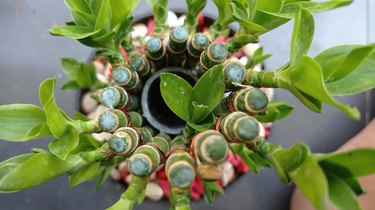
The lucky bamboo plant (Dracaena sanderiana, USDA hardiness zones 9-12) is a beautiful houseplant known as a symbol of luck and prosperity and often used in feng shui practices. Despite its name, lucky bamboo isn't part of the bamboo family; it's a member of the asparagus family (Asparagaceae). It adds a punch of green to your decor, whether you leave the stems straight or train them into twists, swirls, spirals or other shapes. The care for lucky bamboo plants depends largely on whether the plant grows in soil or water, but many of the care requirements are the same.
Location for Lucky Bamboo Plants
Video of the Day
Whether grown in soil or water, lucky bamboo plants love bright, indirect light. If you put your lucky bamboo directly in sunlight, you'll likely notice scorched leaves with brown edges. Move your plant out of direct sunlight if you notice this damage. If the plant growth slows, the color fades or the plant shows stretching in its growth, it likely needs more bright, indirect light.
Video of the Day
The ideal room temperature for your lucky bamboo is between 65 and 95 degrees Fahrenheit, making most indoor spaces suitable for the potted plant. In the winter, placing the plant near a drafty window could result in temperatures below the recommended range. Watch for heating and cooling vents, which can also cause temperature fluctuations in the growing environment.
If your home is dry, add humidity near the lucky bamboo to keep it happy if it's growing in soil. An easy option is to mist the leaves with a spray bottle. A humidifier in the room can also help, or you can place the lucky bamboo container on top of a tray of rocks and water to raise the humidity level. Just make sure the pot bottom is above the water level.
Lucky Bamboo in Soil
If you grow your lucky bamboo in soil, choose a container with good drainage to keep the roots from rotting due to too much moisture. Water your lucky bamboo when the soil feels dry 1 inch deep. Make sure all of the soil gets moistened and empty the excess water from the saucer to avoid oversaturating the soil.
While lucky bamboo often grows well without fertilizing it, you can use liquid houseplant fertilizer once per month to provide nutrients. Dilute it to one-tenth the normal strength. You can use this diluted fertilizer in place of a watering.
Lucky Bamboo in Water
When you grow lucky bamboo in water, it usually goes in a vase or glass container with pebbles in the bottom to hold the bamboo stems steady. Distilled or filtered water is best because it eliminates the salt and chemicals that are often in tap water. Lucky bamboo, as well as other plant members in the Draceaena genus, are susceptible to chemical burns that can cause browning on the tips and edges of the leaves. You can leave tap water out overnight to dissipate some of the chemicals, but you can't get rid of fluoride, which can turn the leaves brown.
Keep the water deep enough to cover the roots at all times. Check daily and add water when needed to submerge the roots. It's a good idea to change the water completely every one to two weeks. When you change the water, clean the rocks and glass container to keep algae and bacteria from growing.
Lucky bamboo growing in water doesn't need much fertilizer either. Dilute to one-tenth the strength or put one or two drops of liquid houseplant fertilizer in the water. If the leaves turn yellow or the stalks start to yellow starting at the bottom, you're likely giving the plant too much fertilizer.
Common Lucky Bamboo Problems
Even when growing indoors, lucky bamboo can have some issues with pests. Mealybugs are small white bugs that you can remove manually. Spider mites often show themselves through fine webbing or fuzz on the lucky bamboo. Use a cotton swab saturated with rubbing alcohol to kill mealybugs and mites. You can also gently spray the plant with water in the shower or sink to remove the bugs.
Root rot can be a problem for lucky bamboo growing in soil. The stalks start to turn brown and mushy when this happens, and the roots are also rotten. You can cut off the healthy parts of the stems and root them in water to regrow the lucky bamboo.
If you're growing the lucky bamboo in water, algae growth in the container can be a problem. This usually means the water has too much fertilizer and sunlight, an ideal combination for algae. Regular cleaning helps control algae. Do an extra cleaning if you notice algae growing. You can also put the lucky bamboo in an opaque container to cut down on sunlight reaching the water.